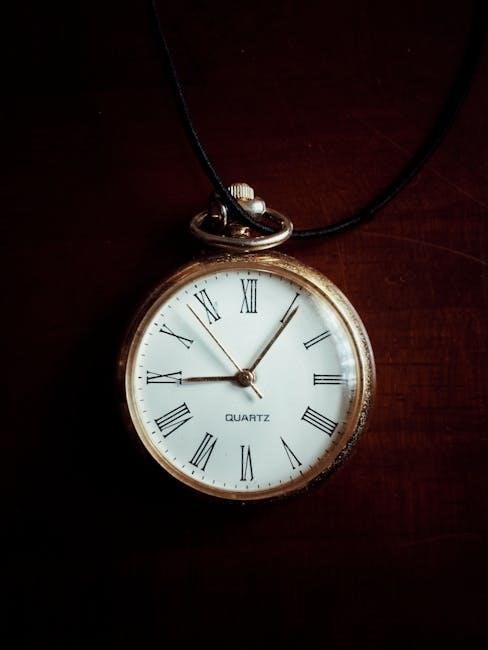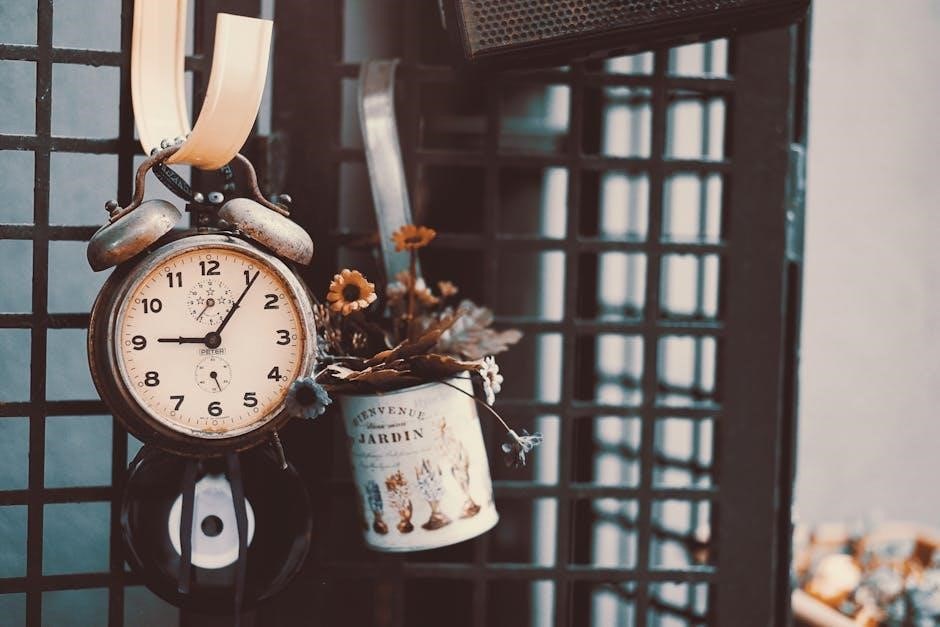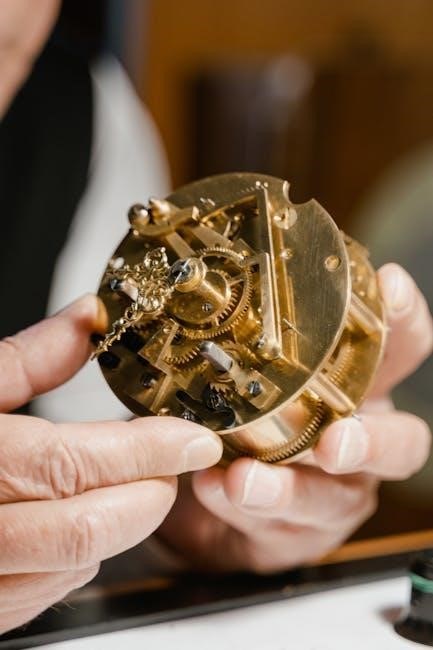Antique clocks vary widely in value based on materials, craftsmanship, and rarity. Mechanical movements often command higher prices than quartz ones. Maker’s marks and historical significance can elevate worth, while restoration may lower value. Researching comparable sales and consulting experts is essential for accurate pricing.
Antique clocks are timeless pieces that combine historical significance with intricate craftsmanship. These clocks, often dating back to the 18th and 19th centuries, reflect the artistic and technical advancements of their eras. From grand grandfather clocks to delicate pocket watches, each piece tells a story of its maker and the period in which it was created. Understanding antique clocks requires a deep appreciation for their mechanical complexity, design, and cultural context. This guide serves as an introduction to the world of antique clocks, helping collectors and enthusiasts identify, value, and care for these treasured timepieces. Whether you’re a seasoned collector or a curious beginner, this guide will provide the foundational knowledge needed to navigate the fascinating realm of antique horology.
Key Characteristics for Identifying Antique Clocks
Identifying antique clocks requires a keen eye for detail and an understanding of their distinctive features. One of the primary characteristics is the materials used in their construction, such as solid wood cases, brass mechanisms, and ornate metalwork. The craftsmanship is often evident in the intricate carvings, engravings, and finishes that reflect the era in which the clock was made.

Mechanical movements are another critical feature, as most antique clocks are powered by spring-driven or weight-driven mechanisms. These movements are typically hand-assembled and bear the marks of skilled horologists. Additionally, the presence of maker’s marks, signatures, or serial numbers can provide valuable clues about the clock’s origin and age.
The design and styling of antique clocks often align with specific historical periods, such as Baroque, Rococo, or Victorian. Features like pendulums, chiming mechanisms, and astronomical displays can further distinguish one clock from another. By examining these key characteristics, enthusiasts can better identify and appreciate the uniqueness of antique timepieces.
Types of Antique Clocks
Antique clocks come in a wide variety of styles and forms, each reflecting the craftsmanship and aesthetic preferences of their time. Grandfather clocks, also known as longcase clocks, are among the most recognizable, featuring tall wooden cases and swinging pendulums. Mantel clocks, smaller and designed for shelf placement, were popular in the 18th and 19th centuries and often featured intricate carvings and ornate details.
Cuckoo clocks, originating from Germany, are known for their animated bird that announces the time. These clocks often feature hand-carved wooden cases and are highly sought after by collectors. Pocket watches, though not stationary clocks, are also considered antiques and were carried by individuals before wristwatches became common.
Other notable types include wall clocks, which were designed to be mounted on walls for practicality, and astronomical clocks, which displayed complex celestial movements. Each type of clock offers unique historical and artistic value, making them treasured additions to any collection. Understanding these distinctions aids in identification and appreciation of antique timepieces.
Determining the Age of an Antique Clock
Determining the age of an antique clock involves examining several key factors. First, consider the materials and construction. Older clocks often feature hand-carved wood or intricate metalwork, which can indicate an earlier period. The design and style of the clock can also provide clues, as certain aesthetics were popular during specific eras.
The clock’s mechanism is another crucial element. Mechanical movements evolved over time, with earlier clocks often having simpler or more primitive mechanisms compared to later models. Look for hallmarkings or signatures, as these can provide direct evidence of the clock’s origin and age.

Additionally, the overall condition of the clock can offer insights, though wear and tear alone is not always a reliable indicator. Comparing the clock to known examples from similar periods can help narrow down its age. Consulting with an expert or referencing historical documents can also aid in accurately dating the clock.
By systematically evaluating these aspects—materials, design, mechanism, maker’s marks, and historical context—you can gain a clearer understanding of the clock’s age and historical significance.
Maker’s Marks and Signatures
Maker’s marks and signatures are essential for identifying and authenticating antique clocks. These marks, often found on the clock’s dial, movement, or case, provide valuable information about the clockmaker and its origins. Clockmakers historically used stamps, engravings, or handwritten signatures to signify their work, making these marks a key factor in determining a clock’s provenance and value.
Some marks are straightforward, featuring the maker’s name or initials, while others may include symbols or codes. Rare or well-known makers’ marks can significantly increase a clock’s worth. For instance, clocks bearing the signature of renowned makers like Thomas Tompion or Abraham-Louis Breguet are highly prized by collectors.
However, identifying these marks can be challenging, as some may be worn, faded, or even forged. Experts often use specialized knowledge and historical records to verify the authenticity of these signatures. Additionally, the presence of a maker’s mark can help date the clock, as certain makers were active during specific periods.
The Role of Materials in Clock Identification
Materials play a crucial role in identifying and valuing antique clocks. The choice of materials often reflects the clock’s era, region, and maker. For instance, clocks from the 18th century frequently used brass or bronze for movements, while wooden cases were common in certain regions. Marble and other stones were popular for mantel clocks during the Victorian era.
High-quality materials, such as intricately carved oak or walnut, can significantly enhance a clock’s value. Conversely, clocks made from less durable or cheaper materials may be less desirable; Additionally, the condition of the materials is vital; clocks with original, well-preserved finishes or components often command higher prices.
Understanding the materials used in a clock’s construction can also help determine its authenticity. For example, early clocks often featured hand-forged components, while later pieces might incorporate mass-produced parts. Experts analyze materials to date clocks and identify their origins, making this aspect indispensable in the identification process.
Mechanical vs. Quartz Movements in Antique Clocks
Antique clocks are primarily distinguished by their movements, which are either mechanical or quartz. Mechanical movements, powered by springs or weights, are the hallmark of traditional clocks and are highly valued for their craftsmanship and historical significance. These movements require regular winding and feature intricate gear systems that showcase the artistry of clockmaking.
Quartz movements, on the other hand, are powered by batteries and use a crystal oscillator to regulate timekeeping. While quartz clocks are more accurate and low-maintenance, they are less common in genuine antiques, as they became prevalent in the 20th century. However, some later “antique-style” clocks may incorporate quartz movements for practicality.

The type of movement significantly impacts a clock’s value. Mechanical movements are often associated with higher prices due to their complexity and historical appeal. Quartz movements, while functional, typically result in lower valuations unless the clock has exceptional decorative or design merit.
Understanding the differences between mechanical and quartz movements is crucial for identifying and appraising antique clocks. Collectors and enthusiasts often prioritize mechanical movements for their authenticity and craftsmanship, making them a key focus in the world of antique horology.
Understanding Clock Periods and Styles

Antique clocks reflect the design trends and cultural influences of their eras, making period and style identification essential for collectors. Early clocks, such as weight-driven mechanical clocks from the 13th to 15th centuries, are rare and highly sought after. The Renaissance period introduced more sophisticated designs, with ornate carvings and intricate mechanisms.
During the 17th and 18th centuries, specific styles like pendulum clocks emerged, with Dutch and English clockmakers leading innovations. The 19th century saw the rise of mass production, making clocks more accessible, while the Victorian era brought elaborate case designs. Each period and style has distinct features, such as the use of materials like oak, walnut, or gilded finishes.
Understanding these styles aids in dating and valuing clocks. For instance, Art Deco clocks from the 1920s to 1940s feature geometric patterns and streamlined forms. Knowing these characteristics helps collectors authenticate and assess the worth of their pieces, making style recognition a cornerstone of antique clock appreciation.
Researching historical design movements and regional craftsmanship is vital for accurately identifying and pricing antique clocks, ensuring that collectors and enthusiasts can fully appreciate their cultural and monetary value.
Price Guide for Antique Clocks
Antique clocks vary significantly in price, ranging from a few hundred to tens of thousands of dollars. The value depends on factors like age, rarity, condition, and provenance. For example, a contemporary-made Montgomery Ward pendulum grandfather clock with a Tempus Fugit face might sell for $150 to $250, while rarer pieces can fetch much higher prices.
High-end antique clocks, such as 18th-century grandfather clocks or intricately crafted French mantel clocks, can exceed $10,000. Restoration quality, originality, and historical significance also impact pricing. Online resources like Kovels’ antique guide and auction house records provide valuable insights for determining fair market values.

Collectors and sellers often consult experts to appraise clocks accurately. Prices may fluctuate over time based on market demand and trends. For instance, clocks with unique mechanisms or those tied to notable makers or historical events command premium prices. Researching similar pieces and staying informed about market trends is essential for buying or selling antique clocks effectively.
Ultimately, the price of an antique clock reflects its cultural, historical, and artistic significance, making each piece a unique investment in timekeeping history.
Factors Affecting the Value of Antique Clocks
The value of antique clocks is influenced by several key factors, including rarity, condition, and historical significance. Rare clocks from renowned makers or specific historical periods often command higher prices. The clock’s condition is critical; original parts, minimal restoration, and functional mechanisms significantly enhance value.
Provenance, or the clock’s ownership history, can also elevate its worth. Clocks with documented ties to notable individuals or events are highly sought after by collectors. Additionally, the materials used in construction play a role, with clocks made from precious metals or high-quality woods being more valuable.
Market demand and trends further impact value, as certain styles or periods may be more popular among collectors. Functional aspects, such as the accuracy of timekeeping or the presence of unique features like chimes or astronomical displays, also affect pricing. Consulting experts and using resources like Kovels’ guides can help determine a clock’s fair market value.
Ultimately, the interplay of these factors determines whether an antique clock is a modest find or a prized collector’s item, making each piece a unique investment in horological history.
How to Research and Verify the Authenticity of an Antique Clock
Authenticating an antique clock involves meticulous research and examination; Start by studying the clock’s maker’s marks, signatures, and historical documentation. These details can help trace its origins and verify its age. Consulting reference materials, such as Kovels’ guides, provides insights into known makers and their styles.
Examine the clock’s condition and craftsmanship. Look for signs of originality, such as patina, and check for any modern components or repairs that might indicate a reproduction. Compare the clock to similar examples in auctions, museums, or collector communities to gauge its legitimacy.
Professional appraisers or horologists can offer expert opinions, especially for rare or high-value pieces. Additionally, researching the clock’s provenance, or ownership history, can strengthen its authenticity. Understanding market trends and pricing data also helps validate its worth.
By combining historical research, physical inspection, and expert consultation, you can confidently verify an antique clock’s authenticity and determine its place in horological history.
Caring for and Maintaining Antique Clocks
Caring for antique clocks requires attention to detail to preserve their functionality and aesthetic value. Regular cleaning is essential, but avoid harsh chemicals or abrasive materials that could damage finishes or mechanisms. Use soft cloths and gentle polishes specifically designed for horological items.
Handle the clock with care, as oils from skin can tarnish metal components. Avoid exposing the clock to direct sunlight, moisture, or extreme temperatures, as these can warp wood, rust metal, or disrupt timekeeping accuracy. Maintain a stable environment to ensure optimal performance.
Wind mechanical clocks regularly to prevent stagnation, but avoid over-winding, which can strain the mechanism. For intricate or valuable pieces, consider consulting a professional horologist for servicing. Avoid DIY repairs, as improper techniques can irreparably damage the clock.
Store the clock in a secure location to prevent accidental damage. Keep documentation, such as maintenance records and appraisals, to track its history and condition. By following these guidelines, you can ensure your antique clock remains a functional and beautiful treasure for generations.